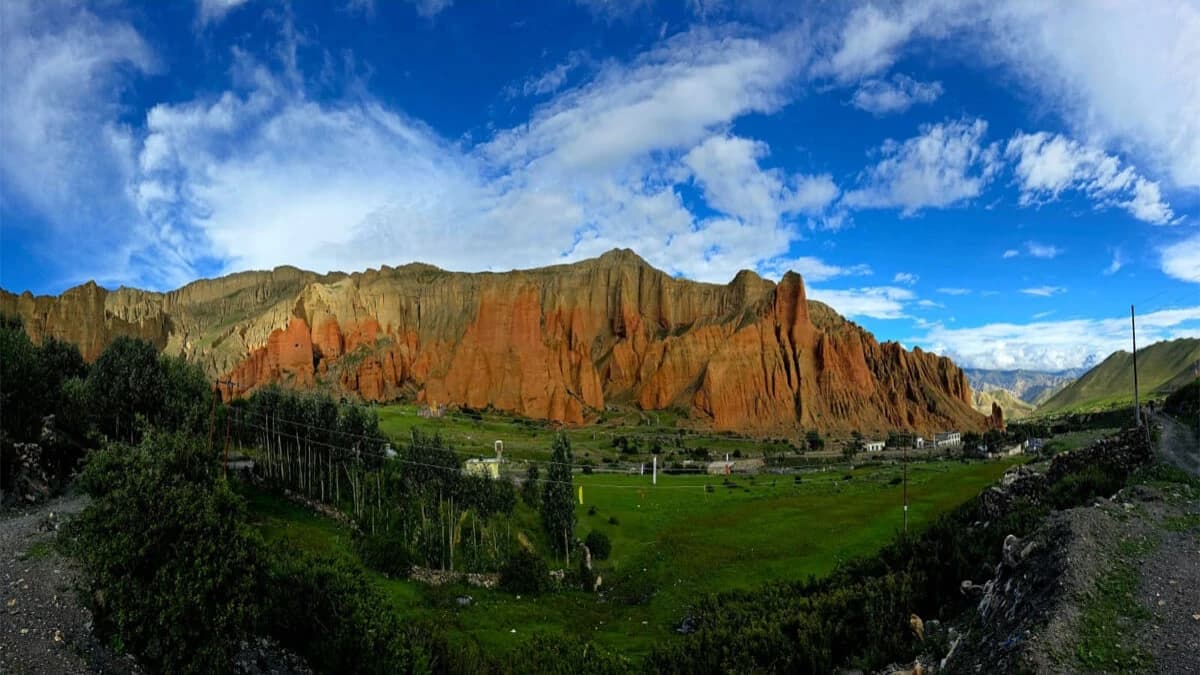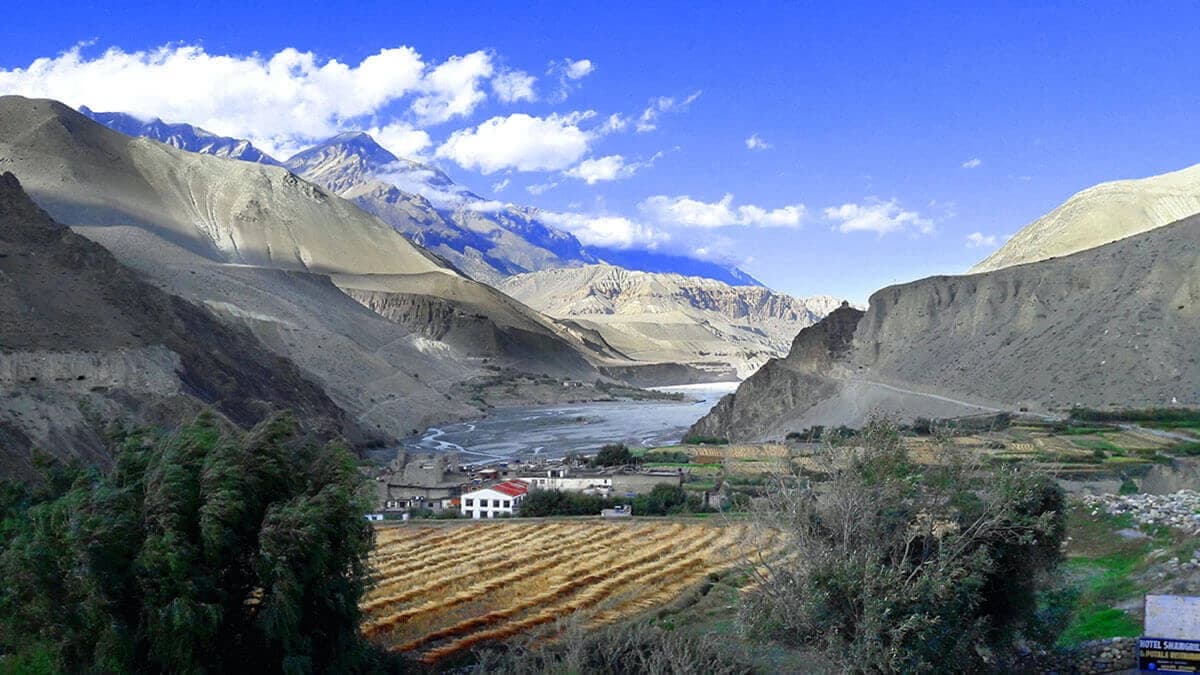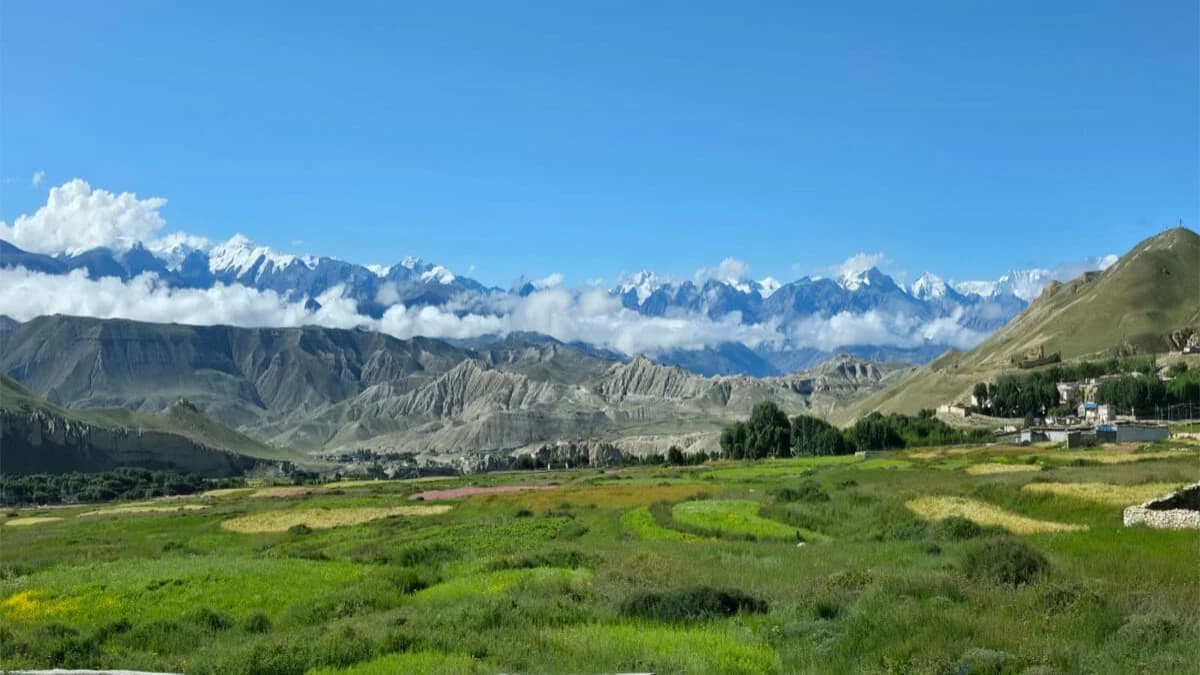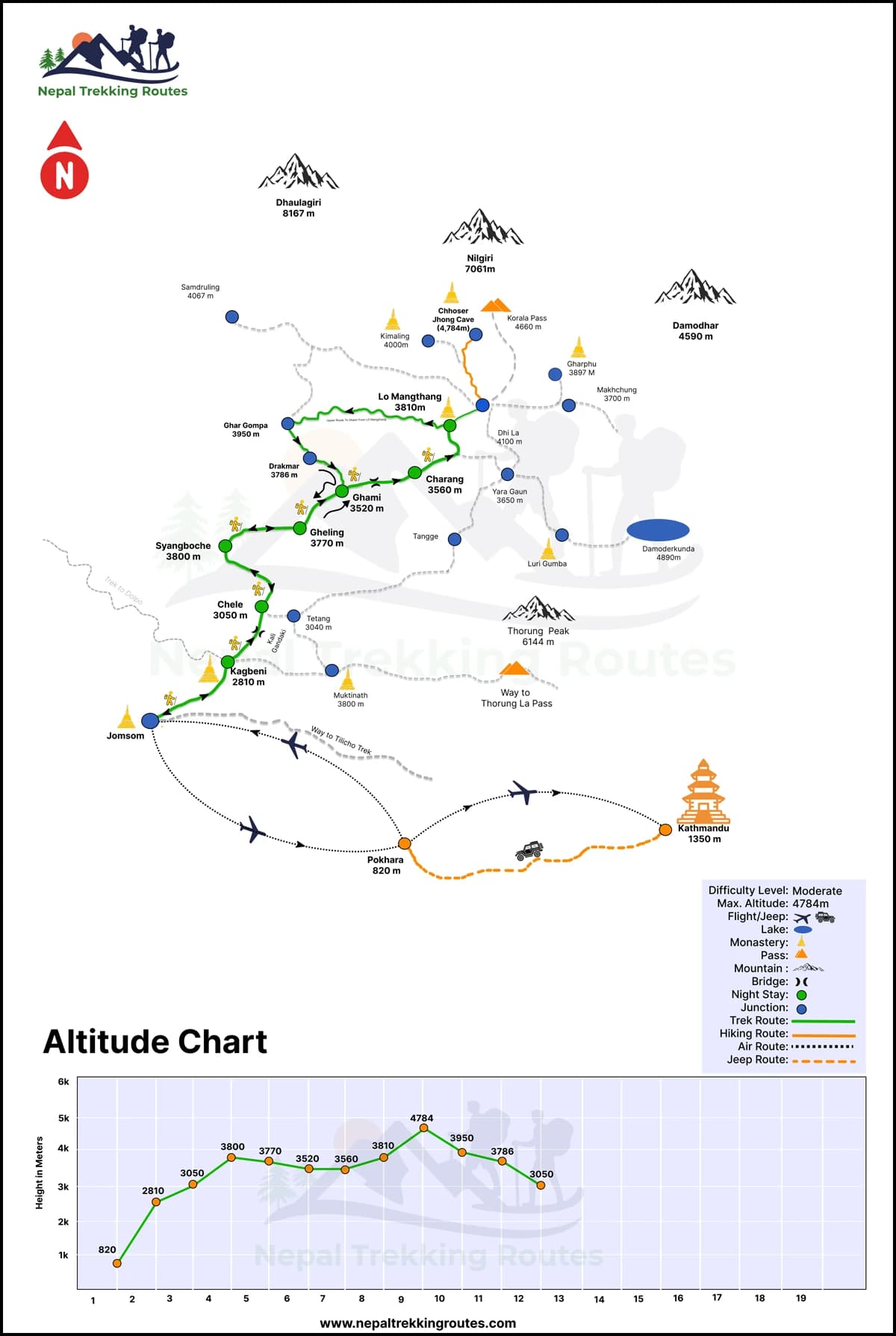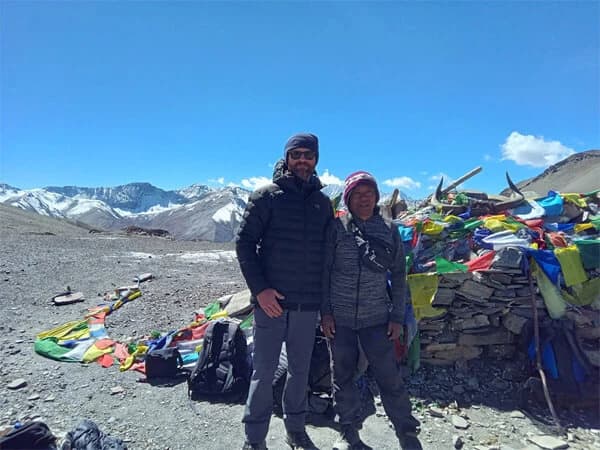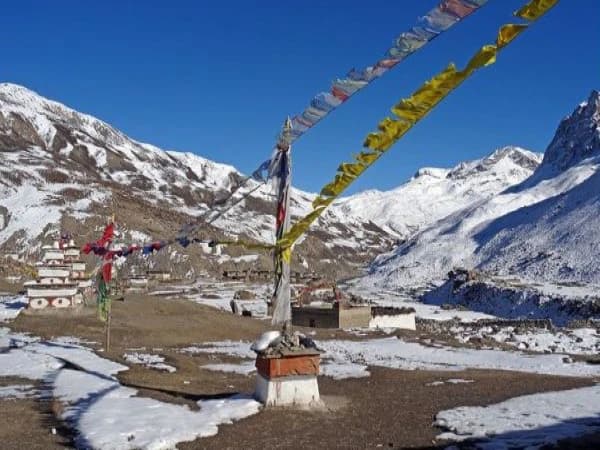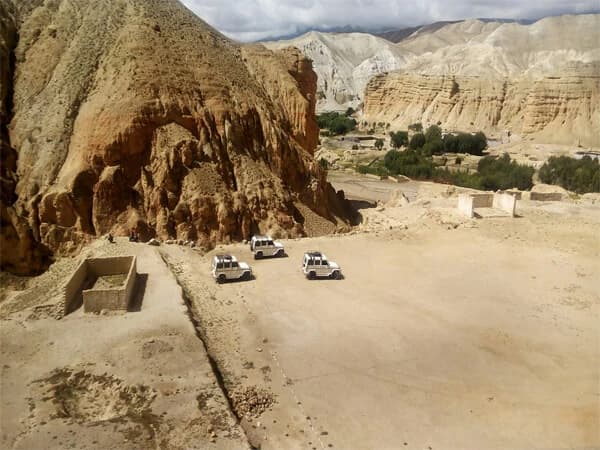Upper Mustang Trekking Overview
Upper Mustang Trek is a unique adventure experience in the Himalayas of Nepal. It is a challenging journey that takes trekkers through the remote and untouched Mustang region to explore its ancient cultural and natural wonders.
Upper Mustang Trekking begins in Kathmandu with a scenic flight to Jomsom, the gateway to the Mustang region. From there, trekkers traverse the Kali Gandaki River valley to the ancient kingdom of Lo Manthang. Along the way, trekkers pass through picturesque villages, monasteries, and stunning landscapes of snowcapped peaks, deep canyons, and rolling hills.
The Upper Mustang Trek in Nepal is renowned for its unique culture and landscapes. Trekkers can explore the ancient monasteries, villages, and forts that are fine throughout the region. They will also have the opportunity to meet the local people and learn about their culture and beliefs.
In addition to cultural exploration, trekkers can enjoy a wide range of outdoor activities. These include mountain biking, rock climbing, hiking, and camping. The stunning views of the Himalayas will make the Nepal trek even more memorable.
Upper Mustang Trek in Nepal is a Remote Himalayan Trek that will last a lifetime. With its spectacular landscapes and rich cultural heritage, the Mustang region is an amazing destination that is perfect for trekkers of all levels.
Upper Mustang Trek is the Hidden Kingdom Trek in the restricted areas while trekking in Nepal. It lies in the famous Mustang district that is known as “the districts across the Himalayas.” It is called so because of its proximity to the Tibetan Plateau. Although it lies in Nepalese territory, it is culturally and geographically influenced by Tibet.
Mustang Trek is famous for its desert-like climate and harsh rock-faced landscapes. It can even be visited in the summer monsoon. Because it is a rain shadow area of Annapurna (8,091 m) and Dhaulagiri (8,167 m) Massifs. When the remaining parts of Nepal trekking experience heavy rainfall and flooding, you can explore the Upper Mustang.
Upper Mustang Trek is a Cultural Trek Nepal that is fairly easy excursion to the ‘Last Forbidden Kingdom’ of Lo Manthang. It shares its border with the Tibetan plateau and has an average altitude above 3,000 m. The ancient monasteries and festivals found in the Lo Manthang Trek are testimonials of Tibetan Buddhist culture and tradition.
The Last Shangri-La of the Northern Himalayas, is populated mainly by a minority group of Tibetan origin. It was previously a restricted area until 1990 to protect the uniqueness of biodiversity, culture, and tradition. Therefore, foreigners still need a special permit to embark through incredible landscapes, prehistoric caves, and age-old monasteries. A large part of the Upper Mustang Region Nepal is like a desert even though there are snow-capped mountains at its northern edge. That is why, it is known as the ‘mountain desert’ of Nepal located across the Himalayas.
Do you want to experience different geographical and socio-cultural diversity from the rest of the other regions of Nepal? If ‘yes’, the Upper Mustang trek can quench your thirst to gain lifelong knowledge about such harsh realities! Moreover, there are a lot of things this Tibetan Culture Trek has to offer you like the bonus stopovers at Jomsom and Muktinath. Some of the major highlight are here.
Upper Mustang Trekking Highlights
- The aerial view of Annapurna and Dhaulagiri ranges including a distant view of the Manaslu region
- The walled city; the Capital City of the Last Forbidden Kingdom of Lo Manthang
- Desert-like but beautiful the harsh landscapes of the rain shadow area
- The lifestyle of the Mustangese people is highly influenced by Tibetan Buddhist culture
- Buddhist monasteries found at least one in a village including the 1200-year-old Ghar Gompa
- Mani walls, prayer flags, and wheels, chortens
- Panorama of picturesque valleys, bizarre landscapes, and snowy peaks of the Annapurna region
- Muktinath Temple, a shrine equally important for both Buddhists and Hindus
Some of the Major Attractions of Upper Mustang Trek Nepal
Experience the Upper Mustang trek is famous for its natural and cultural attractions. You can have a breathtaking view of the snowy peaks of Annapurna and Dhaulagiri ranges. Moreover, Mt. Machhapuchhre (6,693 m), Nilgiri and Tukuche peaks are other beauties of this trek.
Tibetan Buddhist culture, tradition, and lifestyle have influenced the people of Lo Manthang. The 12th or 13th centuries monasteries in almost every village reflect the Buddhist culture and tradition in this region.
The arid landscapes having parched barren hills, Tibetan Plateaus, and housing styles are other attractions. The Sky Caves made around 2,000-3,000 years ago to mummify dead bodies are also something worth visiting. If you do the Upper Mustang trek in May, you can observe the Tiji Festival. It is the most colorful festival, which is celebrated for three days.
The walled city of Lo Manthang is the prime historical site preserving ancient art and artifacts. The Last Forbidden Kingdom, Lo Manthang used to be the Capital City of the hidden kingdom of the Himalayas. The four-story palace of the Mustangese King surrounded by other artistic buildings and shrines is also beautiful.
Additionally, Tinker, the summer palace of the then King is another famous site. You can try riding on horseback to visit this ancient village. It is the last human settlement area of Upper Mustang. From here, you can have the wonderful Lo Manthang Valley and the amazing bizarre landscapes.
The ethnic villages having different housing styles like that of the Igloos are also interesting. The houses have mud roofs to protect the people from freezing temperatures and snowfalls. They are decorated with prayer flags, mane walls, chortens, and prayer wheels. As a whole, the Upper Mustang trek is a trip toward the abode for natural beauty and cultural diversity getting popularity day by day.
The Buddhist Shrines of Mustang Trek
While doing the Upper Mustang trek, you can visit at least a Tibetan Buddhist monastery in every village. Some of them are as old as 1,200 years preserving their uniqueness and religious significance still today. Champu Lakhang (God House), the red Thumchen Gompa, and Chyodi Gompa are the most visited worthy sites. All these monasteries are located in the walled city of Lo Manthang.
The most colorful festival of the Upper Mustang region, Tiji Festival is celebrated on the premises of Chyodi Gompa. The monks perform circle dances in the traditional music by beating the drums in front of the Guru Rinpoche. The native people of the Mustang region gather around to observe the festival and take blessings from the Guru Rinpoche.
Other notable Ancient Monastries Mustang, the hidden kingdom of the Himalayas, are Ghar Gompa and Namgyal Gompa. Ghar Gompa is 1,200 years old monastery located in Gyankar Village. Here, you can see the thanks and other Buddhist paintings preserved as historical manuscripts. A few kilometers away from the ancient Capital City of Mustang lies Namgyal Gompa. It is situated on a foothill, so, you can see the alluring vista of Lo Manthang Valley including the Annapurna and Dhaulagiri Himalayan Ranges.
Historical Caves of Upper Mustang Trek
Upper Mustang trek rewards you with the centuries-old man-made and natural caves found in large numbers. The most notable are the Sky Caves, which is a group of around 10,000 caves made by human beings. The manuscripts and other documents preserved in the cave premises justify that they were built around 2,000 to 3,000 years ago
Located on the bank of the Kali Gandaki River, the Sky Caves are believed to have been built by the then Mustangese people to mummify the dead bodies. If further Cave Exploration Mustang is done, we can find a new twist in the history of humankind. The next is the Rangchung Cave, which is a network of natural caves on the way to Chhusang from Syanmachen.
Tiji Festival Trek: the Most Significant Upper Mustang Cultural Trek Nepal
Tiji Festival is the greatest and most colorful festival celebrated in Upper Mustang. It is celebrated to mark the victory of virtue over vice. The exact date of the celebration of this festival is fixed according to the Chinese calendar. Generally, if falls in the third week of May. Therefore, to become a part of this fabulous Buddhist celebration, you should plan your Upper Mustang Tiji Festival trek at the respective time.
The Mustangese people celebrate this festival to commemorate the legendary figure, Dorje Jono. He is one of the many incarnations of Lord Buddha who came to Earth to protect it from calamities. The myth states that Dorje Jono got victory over the demonic activities' plan to destroy the kingdom through natural catastrophes.
Tiji Festival is celebrated at the premises of Choede Monastery. It is one of the most important Buddhist shrines of the ancient capital of Lo Manthang. It is also known as The Chasing of the Demons Festival. History shows that the Tiji Festival has continuously been celebrated since 500 years back. It further helps to mark the peaceful co-existence of the people of Upper Mustang and the prayer for World Peace.
How much does it cost for Upper Mustang Trek
The Upper Mustang Trek Cost varies depending on factors such as the trek duration, group size, level of service, and whether you choose a guided or independent trek. On average, the cost ranges from $1,800 to $3,500 per person for a standard 12 to 15 day trek.
Nepal Trekking Routesoffers the Upper Mustang Trek Package at a discounted rate of $1,795 which includes transportation, permit fees, guide or porter, accommodation and meals. Here is the breakdown of costs:
- Upper Mustang Trek Permit Fees: Upper Mustang is a restricted region, requiring a Restricted Area Permit (RAP) costing $500 per person for the first 10 days and $50 per additional day. Additionally, trekkers need an Annapurna Conservation Area Permit (ACAP) for $30.
- Guide and Porter Fees: A licensed guide costs around $30-$40 per day, while a porter costs $20-$30 per day. Hiring both ensures a smoother and more enjoyable trekking experience.
- Accommodation and Meals: Teahouses charge $10-$20 per night, and food expenses are around $25-$40 per day.
- Transportation: A round-trip flight from Pokhara to Jomsom costs $120-$150 one way, while a jeep ride may cost around $100-$200.
- Miscellaneous Costs: Travel insurance, tips, and personal expenses can add another $200-$500.
For a luxury upper Mustang Trek package with premium services, costs can go beyond $4,000.
If you have further inquiries about cost, please get in touch with our advisor at Nepal Trekking routes. We ensure a hassle-free and well-organized experience which is worth investing your money.
What are the best Upper Mustang Trek itinerary?
Nepal Trekking Routes offers 14-days Upper Mustang Trek itinerary. The itinerary is well structured with sequence of destinations, activities, and time frames for a journey. It includes details such as daily trekking routes, altitudes, estimated walking hours, accommodation stops, and rest/acclimatization days.
The Upper Mustang Trek Itinerary begins in Pokhara with a flight or drive to Jomsom, the gateway to Mustang. From Jomsom, the trail leads to Kagbeni Village, the entry point of Upper Mustang. The trek continues through Chele, Syanbochen, and Ghami, revealing arid landscapes and ancient monasteries. Passing through Charang, trekkers reach Lo Manthang, the walled capital, rich in Tibetan culture. Exploration includes Chhoser caves and monasteries. The trek concludes in Jomsom with a flight or drive back to Pokhara. Here are the best features of itinerary for Upper Mustang:
- Proper Time Management: Helps trekkers allocate time efficiently for walking, resting, and exploring.
- Safety and Acclimatization: Ensures gradual altitude gain to prevent altitude sickness.
- Logistics and permits: Guides trekkers on necessary permits, transportation, and accommodation.
- Route Planning: Defines the best trails, alternate routes, and important landmarks.
- Expectation Setting: Helps trekkers prepare mentally and physically for daily challenges.
- Emergency Planning: Assists in identifying exit routes and emergency contacts in case of issues.
Is there any Alternative Itinerary option for Upper Mustang Trek Route
An alternative itinerary for the Upper Mustang Trek provides a different perspective of the region. It allows trekkers to explore hidden cultural and natural gems while avoiding crowded trails. It offers varied landscapes, lesser-visited villages like Marpha, Yara, and unique sites such as Luri Gompa, an ancient cave monastery. This route enhances cultural immersion by introducing trekkers to diverse communities and ancient Tibetan-influenced settlements. Choosing an alternative itinerary ensures a fresh experience while maintaining the essence of Upper Mustang’s arid beauty and rich heritage. This itinerary covers the route from Pokhara to Upper Mustang and back.
- Day 1: Arrival in Jomsom & drive to Chele (we would like to start in Chele if possible)
- Day 2: Hike from Chele to Sangboche
- Day 3: Hike from Sangboche to Dhakmar
- Day 4: Hike from Dhakmar to Tsarang
- Day 5: Hike from Tsarang to Lo Manthang via Gar Gompa
- Day 6: Explore Lo Manthang, perhaps hike to Chhoser
- Day 7: Hike from Lo Manthang to Yara
- Day 8: Hike from Yara to Tange
- Day 9: Hike from Tange to Chusang
- Day 10:Hike from Chusang to Ranipauwa
Cost variation for Mustang Trek
The Mustang Trek is a unique adventure trek in the Himalayas. The Mustang Trek is a high-altitude trek in the remote and Off-the-Beaten-Path Nepal. TheUpper Mustang Trek price/cost will vary depending on the length, season, and type of trek you choose.
For the classic Upper Mustang Trek, prices typically start from around US$1,500 per person for a 12-day journey. This includes all necessary permits and fees, accommodation, meals, and transportation to and from the starting point. The price may also include a guide, porter, and/or camping gear, depending on the company you book with.
For a longer trek, such as the Upper Mustang Trek, prices will usually start from around US$2,500 per person. This includes all necessary permits and fees, accommodation, meals, and transportation to and from the starting point. Again, the price may also include a guide, porter, and/or camping gear, depending on the company you book with.
Both the classic Mustang Trek and the Upper Mustang Trek are little challenging treks and require a good level of fitness. While they can be done independently, it is recommended to book with a reliable Nepal trekking company as the terrain can be complicated.
Upper Mustang Trekking Packages
Experience the unique Upper Mustang Trekking with its ancient Tibetan culture, dramatic landscapes, and restricted area charm. Different packages are available depending on your preference for duration, comfort, and cultural experiences. Here are the most popular types:
Standard Upper Mustang Trek 14 days
The standard Upper Mustang Trek 14 days is suitable for classic trekkers who want the full Upper Mustang experience. The maximum elevation is 3,840m at Lo Manthang. This trek is moderately difficult. The accommodation is teahouse based. The cost of the package is $2,000-$2,500 per person including permits, flights, accommodation, meals, and a guide.
Upper Mustang Trek 17 Days with Tiji Festival
The Upper Mustang Trek 17 days with Tiji Festival is best for cultural trekkers wanting to witness the annual Tiji Festival. The maximum elevation is 3,840m. It is a moderately difficult trek with teahouse accommodation. The cost range from $2,500-$3,000 per person including extended stay in Lo Manthang, festival participation, guide and permits.
Luxury Upper Mustang Trek 14-16 days
The Luxury Upper Mustang Trek is suitable for those who prefer more comfort during the trek. The trek is moderate with a trekking duration of 10-12 days. Accommodation is available in upgraded teahouses or lodges with private rooms. The cost ranges from $3,000-$4,500 per person including luxury accommodations, a private guide, porter, and flights.
Upper Mustang Jeep Tour 7-10 days
The Upper Mustang Jeep Tour is suitable for non-trekkers or those who want to explore by road. It is a relatively easy journey with accommodations in hotels and teahouses. The cost ranges from $2,500-$3,500 per person including Jeep, permits, accommodation, and a guide.
Upper Mustang with Muktinath Temple Trek (15 days)
The Upper Mustang withMuktinath TempleTrek is best for pilgrims and trekkers looking for a spiritual journey. This moderately difficult trek takes 12 days of trekking. The cost ranges from $2,000-$2,800 per person including Muktinath Temple visit, guide, permits, accommodation, and meals.
Annapurna Circuit and Upper Mustang
You can also combine Annapurna Circuit and Upper Mustang if you are looking for an extensive trekking experience. Annapurna Circuit trek is moderate trek that takes around 15 days, when combined with Upper Mustang Trek, it can take around a month to complete. It is suitable for the professional trekkers and adventure seekers.

